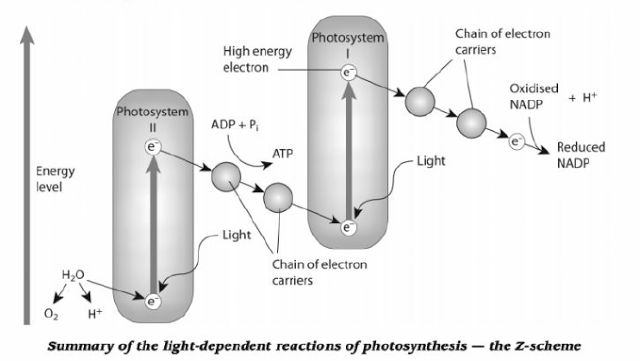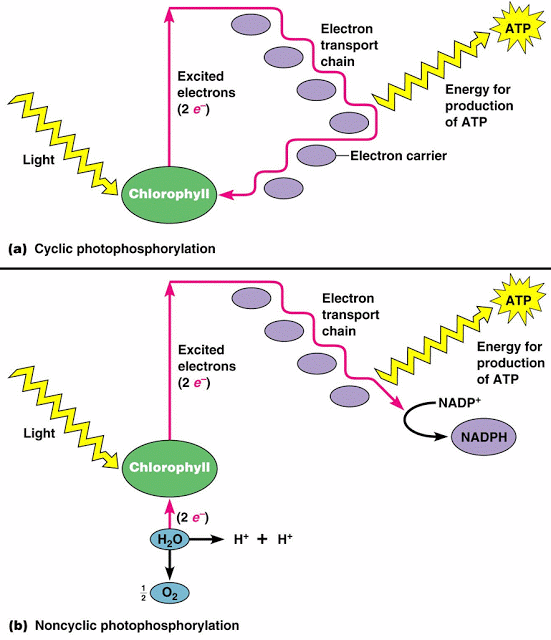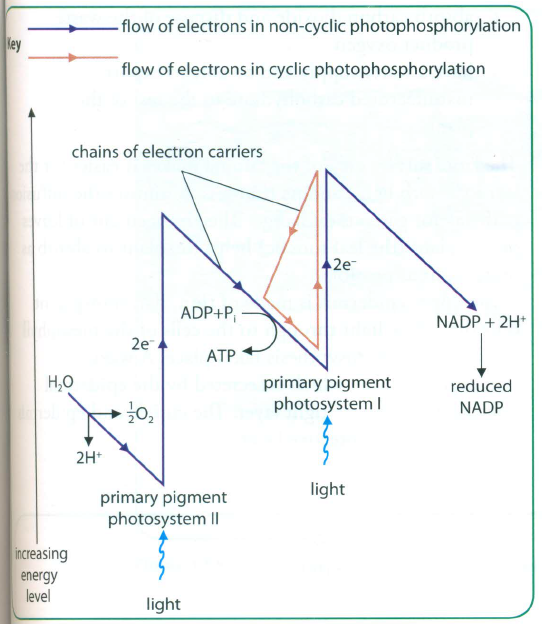Biology
 Chlorophyll molecules in photosystern I (PSI) and photosystern II (PSII) absorb light energy. The energy excites electrons, raising their energy level so that they leave the chlorophyll. The chlorophyll is said to be photo-activated.
Chlorophyll molecules in photosystern I (PSI) and photosystern II (PSII) absorb light energy. The energy excites electrons, raising their energy level so that they leave the chlorophyll. The chlorophyll is said to be photo-activated.
PSII contains an enzyme that splits water when activated by light. This reaction is called photolysis ('splitting by light'). The water molecules are split into oxygen and hydrogen atoms. Each hydrogen atom then loses its electron, to become a positively charged hydrogen ion (proton), H+.
The electrons are picked up by the chlorophyll in PSII, to replace the electrons they lost. The oxygen atoms join together to form oxygen molecules, which diffuse out of the chloroplast and into the air around the leaf.

The electrons emitted from PSII are picked up by electron carriers in the membranes of the thylakoids. They are passed along a chain of these carriers, losing energy as they go. The energy they lose is used to make ADP combine with a phosphate group, producing ATP. This is called photophosphorylation. At the end of the electron carrier chain, the electron is picked up by PSI, to replace the electron the chlorophyll in PSI had lost.
The electrons from PSI are passed along a different chain of carriers to NADP. The NADP also picks up the hydrogen ions from the split water molecules. The NADP becomes reduced NADP.
We can show all of this in a diagram called the Z-scheme. The higher up the diagram, the higher the energy level. If you follow one electron from a water molecule, you can see how it
? is taken up by PSII
? has its energy raised as the chlorophyll in PSII absorbs light energy
? loses some of this energy as it passes along the electron carrier chain
? is taken up by PSI
? has its energy raised agaln as the chlorophyll in PSI absorbs light energy
? becomes part of a reduced NADP molecule

At the end of this process, two new substances have been made. These are ATP and reduced NADP. Both of them will now be used in the next stage of photosynthesis, the light-independent reactions.
Non-cyclic and cyclic photophosphorylation
The sequence of events just described and shown in the flow diagram above is known as non-cyclic photophosphorylation.
There is an alternative pathway for the electron that is emitted from PSI. It can simply be passed along the electron transport chain, then back to PSI again. ATP is produced as it moves along the electron transport chain (photophosphorylation). However, no reduced NADP is produced. This is called cyclic photophosphorylation.

Video: Photosynthesis
- #104 Separating Chlorophyll Pigments By Thin Layer Chromatography (tlc)
Chromatography is a method of separation that relies on the different solubilities of different solutes in a solvent. A mixture of chlorophyll pigments is dissolved in a solvent, and then a small spot is placed onto chromatography paper. The solvent gradually...
- #103 The Light-independent Reactions (calvin Cycle)
The light-independent reactions take place in the stroma of the chloroplast, where the enzyme ribulose bisphosphate carboxylase, usually known as rubisco, is found. 1. Carbon fixation CO2 diffuses into the stroma from the air spaces within the...
- #101 Photosynthetic Pigments
Photosynthetic pigments are pigments presented in chloroplasts or photosynthetic bacteria. They capture light energy necessary for photosynthesis and convert it to chemical energy. PigmentsA pigment is any substance that absorbs light.The color...
- #100 Chloroplasts
Photosynthesis takes place inside chloroplasts. These are organelles surrounded by 2 membranes, called an envelope. Chloroplasts are found in mesophyll cells in leaves: - Palisade mesophyll cells contain most chloroplasts. - Spongy...
- #98 Photosynthesis Syllabus
13.1 Photosynthesis as an energy transfer process 13.2 Investigation of limiting factors 13.3 Adaptations for photosynthesis Photosynthesis is the energy transfer process that is the basis of much of life on Earth....
Biology
# 102 The light-dependent reactions, Photophosphorilation

PSII contains an enzyme that splits water when activated by light. This reaction is called photolysis ('splitting by light'). The water molecules are split into oxygen and hydrogen atoms. Each hydrogen atom then loses its electron, to become a positively charged hydrogen ion (proton), H+.
The electrons are picked up by the chlorophyll in PSII, to replace the electrons they lost. The oxygen atoms join together to form oxygen molecules, which diffuse out of the chloroplast and into the air around the leaf.

 |
| The light- dependent reactions. Credit: Pears education. |
The electrons from PSI are passed along a different chain of carriers to NADP. The NADP also picks up the hydrogen ions from the split water molecules. The NADP becomes reduced NADP.
We can show all of this in a diagram called the Z-scheme. The higher up the diagram, the higher the energy level. If you follow one electron from a water molecule, you can see how it
? is taken up by PSII
? has its energy raised as the chlorophyll in PSII absorbs light energy
? loses some of this energy as it passes along the electron carrier chain
? is taken up by PSI
? has its energy raised agaln as the chlorophyll in PSI absorbs light energy
? becomes part of a reduced NADP molecule

The sequence of events just described and shown in the flow diagram above is known as non-cyclic photophosphorylation.
There is an alternative pathway for the electron that is emitted from PSI. It can simply be passed along the electron transport chain, then back to PSI again. ATP is produced as it moves along the electron transport chain (photophosphorylation). However, no reduced NADP is produced. This is called cyclic photophosphorylation.
 |
| Z- cheme. |
Video: Photosynthesis
Syllabus: 13.1 Photosynthesis as an energy transfer process Light energy absorbed by chloroplast pigments in the light dependent stage of photosynthesis is used to drive reactions of the light independent stage that produce complex organic compounds. Chromatography is used to identify chloroplast pigments and was also used to identify the intermediates in the Calvin cycle. a) explain that energy transferred as ATP and reduced NADP from the light dependent stage is used during the light independent stage (Calvin cycle) of photosynthesis to produce complex organic molecules b) state the sites of the light dependent and the light independent stages in the chloroplast c) describe the role of chloroplast pigments (chlorophyll a, chlorophyll b, carotene and xanthophyll) in light absorption in the grana d) interpret absorption and action spectra of chloroplast pigments e) use chromatography to separate and identify chloroplast pigments and carry out an investigation to compare the chloroplast pigments in different plants (reference should be made to Rf values in identification) f) describe the light dependent stage as the photoactivation of chlorophyll resulting in the photolysis of water and the transfer of energy to ATP and reduced NADP (cyclic and non-cyclic photophosphorylation should be described in outline only) g) outline the three main stages of the Calvin cycle: ? fixation of carbon dioxide by combination with ribulose bisphosphate (RuBP), a 5C compound, to yield two molecules of GP (PGA), a 3C compound ? the reduction of GP to triose phosphate (TP) involving ATP and reduced NADP ? the regeneration of ribulose bisphosphate (RuBP) using ATP h) describe, in outline, the conversion of Calvin cycle intermediates to carbohydrates, lipids and amino acids and their uses in the plant cell |
- #104 Separating Chlorophyll Pigments By Thin Layer Chromatography (tlc)
Chromatography is a method of separation that relies on the different solubilities of different solutes in a solvent. A mixture of chlorophyll pigments is dissolved in a solvent, and then a small spot is placed onto chromatography paper. The solvent gradually...
- #103 The Light-independent Reactions (calvin Cycle)
The light-independent reactions take place in the stroma of the chloroplast, where the enzyme ribulose bisphosphate carboxylase, usually known as rubisco, is found. 1. Carbon fixation CO2 diffuses into the stroma from the air spaces within the...
- #101 Photosynthetic Pigments
Photosynthetic pigments are pigments presented in chloroplasts or photosynthetic bacteria. They capture light energy necessary for photosynthesis and convert it to chemical energy. PigmentsA pigment is any substance that absorbs light.The color...
- #100 Chloroplasts
Photosynthesis takes place inside chloroplasts. These are organelles surrounded by 2 membranes, called an envelope. Chloroplasts are found in mesophyll cells in leaves: - Palisade mesophyll cells contain most chloroplasts. - Spongy...
- #98 Photosynthesis Syllabus
13.1 Photosynthesis as an energy transfer process 13.2 Investigation of limiting factors 13.3 Adaptations for photosynthesis Photosynthesis is the energy transfer process that is the basis of much of life on Earth....
